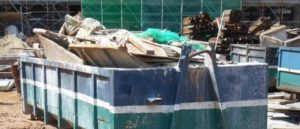
Image source: https://images.theconversation.com
In the US alone, construction waste accounts for around 1/3rd of the total waste. such high statistics, it is no surprise that we at Junk Junkys did some digging around. Further, we came up with some ideas on how to dispose of construction waste safely.
Often, there is excess virgin material left behind, which can be donated. Hence, a combination of donation, recycling and disposal is the right approach to take with construction waste.
Keeping that in mind, if you have got any junk removal tasks that need to be done, don’t hesitate to drop us a call! Until then, let us tell you how you can safely dispose of construction waste!
What is construction waste?
The waste created during the demolition of roads, bridges, houses or during the renovation or construction of homes, offices, etc., is known as ‘construction waste’.
This waste is also known as construction and demolition waste or C&D waste. If the C&D waste can be recycled and reused, it should prevent using virgin material. As we mentioned earlier, you can always rely on a junk removal company to haul away any C&D waste you may have.
Classification of construction waste
Construction and demolition waste can be classified into hazardous and non-hazardous, degradable and non-degradable. Hazardous waste meaning that which affects the environment negatively, while degradable means those wastes that degrade faster.
However, the essential classification is based on hazardous and non-hazardous construction and demolition waste.
Examples of construction waste
Some of the examples of construction and demolition waste that need junk removal are:
- Asphalt
- Bricks
- Concrete
- Glass
- Metals
- Rocks
- Wood
- Paint
- Varnish
- Resins
- Adhesives
- Utility poles
- Lead-based paint
- Products with mercury
- Materials with asbestos

Five ways to dispose of construction waste
Below let’s look at how a junk removal service can help you remove the construction and demolition waste at your place.
- Donate the leftover construction waste
Some construction materials, like sand, cement, and bricks, which may have been ordered and paid for, are unnecessary once construction is over. Instead of disposing of these and seeing them end up in the landfills, it is advisable to donate them to people who may require them. Charities, friends and family, might find a use for these materials, so donate rather than ditch.
- Reuse or recycle construction waste
There are different ways whereby one can reuse or recycle construction waste. For example, wood can be turned into engineered wood, concrete, and rubble into aggregate concrete, and metals can be changed into new metal forms.
Also, one can repair the items that are broken or mangled. For example, broken tools can be fused. Moreover, sometimes they can be used as decorative items as well.

www.highspeedtraining.co.uk
3. Landfilling of non-hazardous construction waste
Sending the non-hazardous C&D waste to landfills is the safest option available. Mostly, landfills do not allow hazardous chemical or industrial waste. The type of waste they allow is as follows:
- Road work construction waste
- Renovation waste
- Site clearance waste
4. Safe disposal of mercury-containing waste
Items containing mercury need to be taken to mercury consolidation sites or recycling sites specifically targeted at recycling mercury. Hence, to remove these items, you will need to label and store the items containing mercury items separately. Examples of mercury items are:
- fluorescent lamps
- cathode-ray tubes
- coal conveyor systems
- elevator control panels
- emergency lighting systems
- exit signs
- manometers
- mercury vapor lamps
- neon lamps
- old paint
- security systems
- silent wall switches
- smoke detectors
- thermometers
- thermostat probes
If you need mercury junk removal, don’t hesitate to get in touch with Junk Junkys!
5. Disposal of lead-based items.
We consider lead-based paint and other lead waste as hazardous waste. Here’s how to dispose of the same:
- You can bag paint chips, dirt, and dust before disposing
- Separate items that are lead-based and store them in separate containers.
- To know more about how to dispose off lead-based items, you can always contact us.
Hence, there’s no need to search for “junk removal near me” when you have Junk Junkys to help you with your waste disposal.
When you seek to reuse construction material, you are in effect. Reducing your total bill towards the project. You can also donate to charities in and around the San Diego area instead of calling a for junk removal San Diego.

Image source: www.gosmartbricks.com
Moreover, before you send waste for disposal, it should be classified in a log with the kind of waste that it is. This helps in the disposal process greatly. Further, some items like windows, tiles and doors can be reused by other construction sites.
In conclusion, we discussed some of the ways to perform junk removal for different types of waste. Also, we hope that the classification of waste into hazardous and non-hazardous materials helped us understand that construction waste requires careful management.

